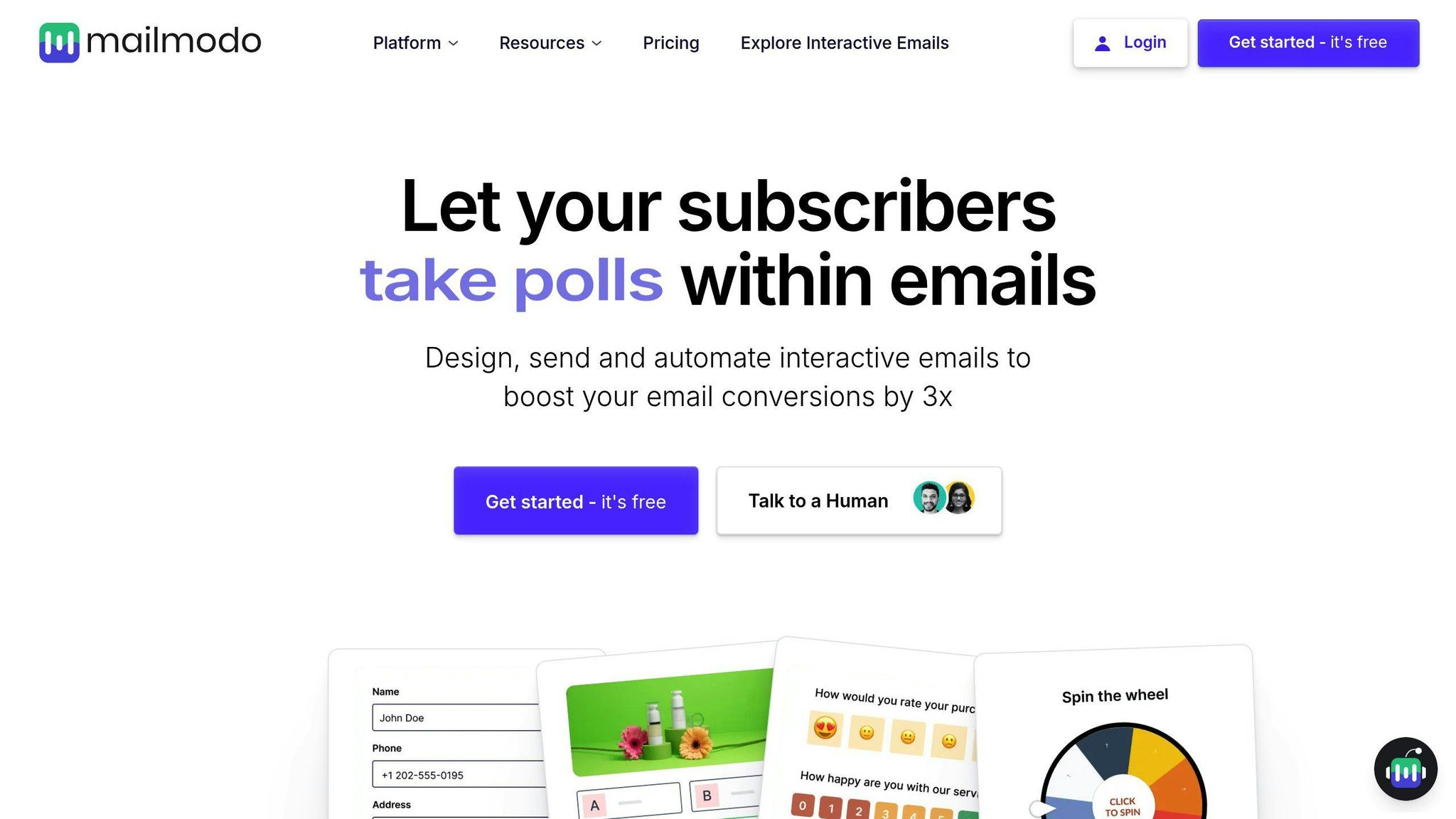Want to make your emails more engaging? Add carousels. Email carousels let you showcase multiple products, features, or promotions in one compact, interactive design. They can boost click-through rates by up to 19% and improve mobile interaction by 28%.
Here’s what you need to know:
- What They Are: Carousels are dynamic slideshows built with HTML and CSS or drag-and-drop tools.
- Why Use Them: They save space, increase engagement, and improve email performance.
- Challenges: Limited support in some email clients (e.g., Gmail, Outlook), slower load times, and accessibility issues.
- How to Build: Use tools like Mailmodo for simplicity or AMP HTML/CSS for full control.
- Best Practices: Optimize images (≤200KB), test for compatibility, and include fallback designs for unsupported clients.
Whether you use no-code builders or custom code, carousels can transform your email campaigns - just keep file sizes small, test thoroughly, and maintain clean email lists for the best results.
Create interactive emails with Mailmodo

Tools for Email Carousel Creation
Creating email carousels can be approached in two main ways: using drag-and-drop builders or writing custom code. The choice depends on your technical expertise, available resources, and project needs. Both methods address challenges like email client compatibility and load times.
Drag-and-Drop Email Builders
Modern email builders make it easy to create carousels with minimal effort. Platforms like Mailmodo and FreshInbox offer tools designed to ensure carousels display correctly across various email clients. These tools are especially helpful for non-technical teams or those with tight timelines.
Here’s a quick comparison of some popular platforms:
| Platform | Key Features | Ideal Use Case |
|---|---|---|
| Mailmodo | Live inventory integration, high compatibility | E-commerce campaigns |
| FreshInbox | Gamification tools, dynamic content loading | Interactive newsletters |
| Litmus Builder | GIF carousel support, click tracking | Marketing automation |
Code-Based Solutions
For those with coding expertise, building carousels using AMP HTML and CSS provides more flexibility. This approach allows for advanced customization but requires careful testing to ensure compatibility across email clients. Key techniques include:
- Using AMP-list components for loading dynamic content.
- Leveraging CSS sibling selectors to create navigation controls.
- Employing nested tables for broader client support.
While this method offers complete control, it’s more time-intensive and demands technical know-how.
Choosing Your Build Method
Deciding between a no-code builder and custom coding depends on factors like time, customization needs, and maintenance capabilities. Here’s a side-by-side look:
| Factor | No-Code Builder | Custom Code |
|---|---|---|
| Client Support | Auto-generated fallbacks | Requires manual coding |
| Development Time | Quick (2-4 hours) | Longer (15-20 hours) |
| Maintenance | Automatic updates | Ongoing testing needed |
| Customization | Limited by platform features | Full control |
Platforms like Stripo are great for teams without coding expertise, while enterprises often combine drag-and-drop tools with custom AMP components for maximum flexibility.
Email Carousel Setup Guide
Content Preparation
Once you've chosen your build method, it's time to fine-tune your content for performance and compatibility.
- Images: Use high-resolution visuals that are at least 600px wide. Keep file sizes under 200KB by compressing them with tools like TinyPNG. Stick to a 2:3 aspect ratio for slides optimized for mobile screens.
- Text: Keep it short and impactful - 20 to 30 words per slide works best.
- Branding: Many retailers use fixed branding panels with rotating highlights to ensure their emails stay consistent.
Here’s a quick look at the recommended specifications for your assets:
| Asset Type | Requirement |
|---|---|
| Images | JPEG/PNG, ≤200KB |
| Text overlay | ≤30 words |
| CTA buttons | Minimum size 44x44px |
Carousel Construction
The way you build your carousel depends on the method you choose. Here’s a breakdown of two common approaches:
AMP HTML Implementation
For AMP HTML, use the <amp-carousel> component. This option is ideal for Gmail, Yahoo Mail, and Outlook.com users. It comes with built-in features like mobile swipe support and automatic lazy loading.
CSS-Based Carousels
If you go with a CSS-based approach, follow these steps:
1. Base Structure Setup
Use nested tables with radio inputs to control the slides. CSS sibling selectors (:checked ~ .slide) handle the transitions between slides.
2. Fallback Implementation
Include static images within <noscript> tags for email clients that don’t support carousels. To avoid layout issues on mobile, limit the maximum width to 320px.
3. Navigation Controls
Position navigation buttons with absolute positioning to ensure compatibility with Outlook. Add ARIA labels (aria-live="polite") to make sure the carousel is accessible.
This setup ensures your carousel works across different email clients while delivering the engagement benefits mentioned earlier.
Testing Process
Testing is key to making sure your carousel works as expected. For example, Xfinity saw a 23% boost in click-through rates when they used well-tested carousels compared to static images.
Here’s what to focus on during testing:
| Test Type | Success Metric |
|---|---|
| Client Rendering | Consistent display across clients |
| Load Time | Less than 3 seconds |
| Engagement | More than 35% slide interaction |
Make sure your carousel meets accessibility guidelines. Check that color contrast ratios follow WCAG 2.1 standards (minimum 4.5:1) and verify all buttons or links have enough space for easy tapping.
Use tools like Litmus to test across different email clients. Keep an eye on key metrics like load time (under 3 seconds) and slide engagement (above 35%). Well-optimized carousels often keep users engaged for over 8 seconds per slide.
Email Carousel Standards
Mobile Design Rules
Optimizing email carousels for mobile devices is a must. Navigation buttons should have touch targets of at least 48x48px with 8px spacing between interactive elements to avoid accidental taps. This ensures smooth interaction across different mobile email clients and screen sizes.
Here are the key technical specifications for mobile-friendly carousels:
| Element | Mobile Requirement |
|---|---|
| Image Width | Max 600px |
| Touch Target | Min 48x48px |
| Spacing | 8px minimum |
| Layout | Single-column |
Using vertical swipe gestures can greatly enhance the user experience on mobile devices. For Android Gmail, where CSS animations are often disabled, use GIF fallbacks with a maximum of three frames. To address vertical stacking issues in Samsung Mail, apply max-height:0 toggles.
Backup Display Options
Always include fallback options to ensure your email displays properly across all platforms. Start with a strong static image as the primary backup and use MSO conditionals for Outlook compatibility.
For example, wrap animated elements in MSO conditional statements for Outlook and Windows Live Mail users:
<!--[if mso]>
<div class="static-content">
<!-- Fallback content here -->
</div>
<![endif]-->
This approach ensures that your email remains functional and visually appealing, even on platforms with limited support for animations.
Email List Management
Even the best-designed carousels won't perform well if your email list isn't properly maintained. Clean lists can increase carousel engagement by 15-20%. Invalid email addresses not only waste resources but also distort engagement metrics.
Key metrics to monitor include:
| Metric | Target | Impact |
|---|---|---|
| Bounce Rate | <2% | Better deliverability |
| Invalid Address Detection | >95% | Fewer spam flags |
| List Cleaning Frequency | Every 30-45 days | Consistent performance |
Automating list cleaning helps prevent spam traps and ensures your carousel emails reach the intended audience.
Summary
Key Insights
Email carousels are proving to be a game-changer for engagement, driving a 15-25% boost in conversion rates for featured products. To make them work, you need to focus on the technical side: use 600px-wide optimized images and ensure correct nested table structures with sibling selectors for compatibility across email clients.
Xfinity's success highlights how proper execution can directly influence campaign results. The recipe for success? Optimized images, thorough client compatibility testing, and keeping your email lists clean and up-to-date for better delivery and engagement.
Recommended Tools
Here are some tools to help you create and maintain effective carousels:
| Tool Type | Suggested Tool |
|---|---|
| Carousel Creation | Mailmodo |
| Compatibility Checks | Email on Acid |
| List Management | Bounceless.io |
Bounceless.io plays a key role in keeping email lists healthy by detecting spam traps and reducing bounces. Plus, as AMP adoption grows, carousels are becoming even more accessible and engaging for users.

